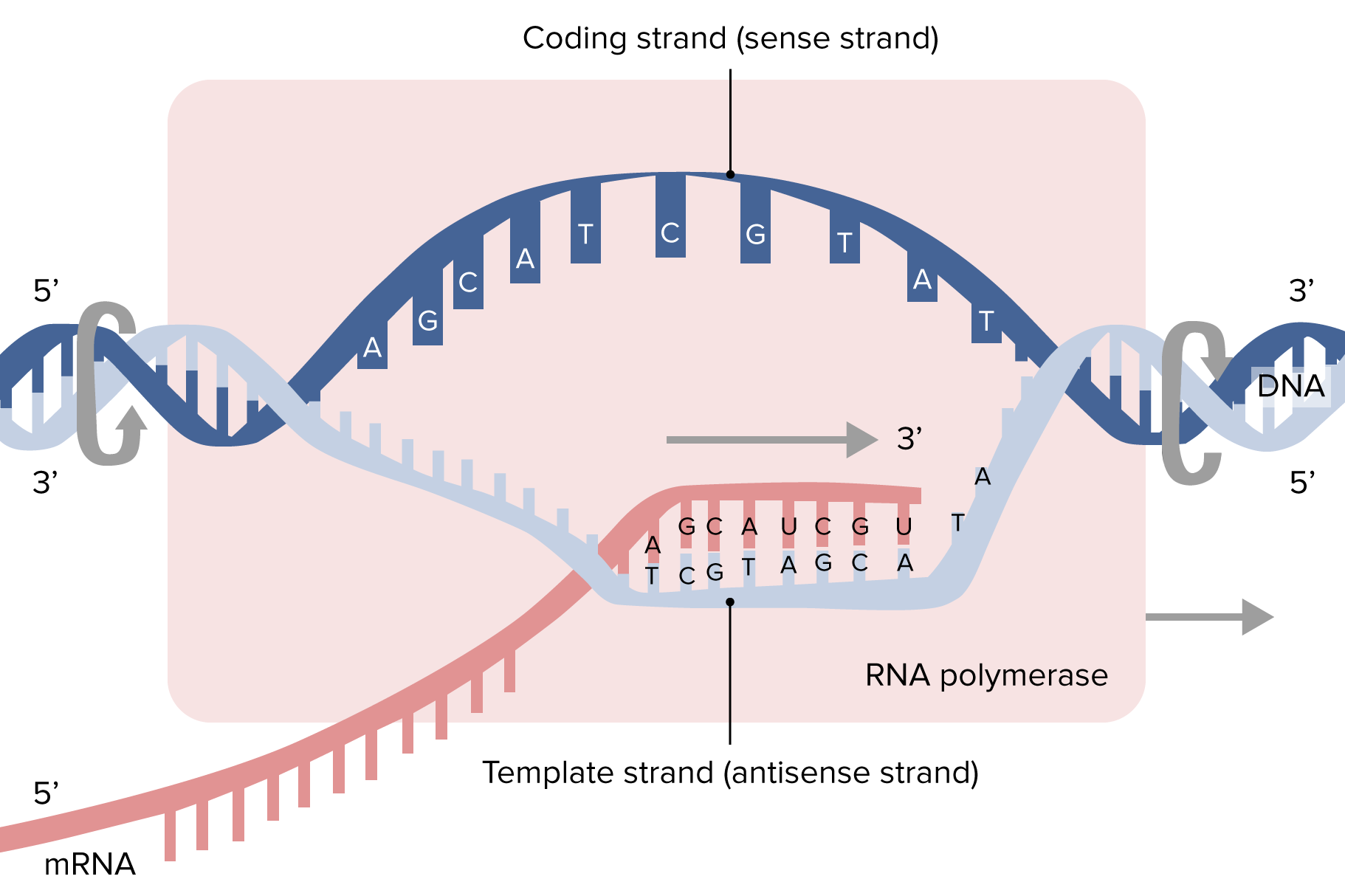Playlist
Show Playlist
Hide Playlist
Transcription: Introduction
-
Slides 07 TranscriptionProkaryotesEukaryotes Genetics.pdf
-
Reference List Molecular and Cell Biology.pdf
-
Download Lecture Overview
00:01 In our first lecture on gene expression, I introduced you to the processes of transcription and translation in prokaryotes and eukaryotes as well as introducing you to the genetic code. 00:14 Now, it’s time to dig a little deeper into the process of transcription. 00:18 So without ado, let’s move forward. 00:21 By the end of this lecture, you will be able to describe transcription in prokaryotes as well as differentiate between the initiation, elongation and termination phases of transcription as well as explain differences in prokaryotic and eukaryotic transcription and diagram aspects of RNA processing. 00:43 So to start with, I’d like to ask you a question from the previous lecture. 00:48 Can you recall any differences from prokaryotic and eukaryotic gene expression? I’ll give you a hint. 00:55 It has to do with the structure of the cells. 00:59 But let’s move forward and see if we can answer some of those questions one more time. 01:03 First of all, this was figure we used to introduce the process of transcription, looking at a transcription bubble and the pink square represents the entire RNA polymerase and we are simply using the template strand to make a messenger RNA that looks like the coding strand and that messenger RNA can then go on to be translated in a future lecture. 01:30 So in this lecture, I’d like to introduce you to the idea that RNA polymerase is not quite as simple as a pink box. 01:39 We know that there are several domains to the RNA polymerase and there’s the core enzyme. 01:46 That core enzyme is really in charge of doing the synthesis of RNA and adding RNA nucleotides to the growing messenger RNA. 01:56 However, there are some other subunits associated with the core enzyme that actually helped get the core enzyme onto to the DNA in the right location and read it in the right direction. 02:08 All of these pieces together, we call the holoenzyme. 02:12 So the holoenzyme is the whole enzyme. 02:15 That whole enzyme is going to associate itself with the DNA strand in the correct location and the holoenzyme will recognize the promoter sequence for the DNA, and it will bind to that DNA and begin the process of transcribing the genes. 02:35 So this is the phase of where I’m at laptop in my office and I am hitting print so that I can print the recipe and take a copy that I can get dirt all over in my kitchen and make the recipe. 02:50 So right now, we’re taking the copy and let me introduce you to the promoter sequence. 02:56 The promoter sequence is before the start site for transcription and the enzyme will dock onto this. 03:05 The holoenzyme will dock onto this promoter sequence. 03:08 These promoter sequences in prokaryotes have some distinct regions. 03:12 There are two sites of sequences that are very common and conserved in all bacterial cells. 03:19 There is a -35 base sequence. 03:23 So this is 35 base pairs before the start site that’s why we call it -35. 03:30 And it has a very conserved sequence. 03:32 And then we have the -10 sequence, so 10 base pairs before the start site. 03:40 So the holoenzyme docks onto this promoter region and unwinds a very small region of the DNA, starting at the -10 sequence and only begins transcription at the start site and continues in that direction. 03:56 How does it know which way to go? Well, because of the orientation of these two pieces, the -35 and the -10 sequence, we can get directionality, which direction the polymerase needs to read, and which strand is the template strand and which strand is the coding strand. 04:15 So the asymmetry of these two locations allows the polymerase to know which direction to go. 04:22 So here we have initiated transcription.
About the Lecture
The lecture Transcription: Introduction by Georgina Cornwall, PhD is from the course Gene Expression.
Included Quiz Questions
Two 6-base sequences are present in bacterial promoters: TATAAT at the -10 position and TTGACA at the -35 position. What is the significance of these two base sequences being different? (Select all that apply)
- It allows for the location of the start site and the direction of transcription to be identified.
- It allows RNA polymerase to distinguish between the template strand and the coding strand of the DNA molecule.
- They are individual binding sites for both the core polymerase and the holoenzyme.
- They are individual binding sites for both the holoenzyme and ATP.
- They allow extra proteins to attach to DNA polymerase to form a holoenzyme.
Which of the following is the most accurate definition of a promoter?
- A DNA sequence to which proteins bind to start transcription
- A regulator region on the 5' end of a template strand of DNA where RNA polymerase binds to initiate transcription
- A regulator region on the 3' end of a template strand of DNA where RNA polymerase binds to initiate transcription
- A regulator region on the 3' end of a gene where DNA polymerase binds to initiate replication
- A regulator region on the 3' end of a coding strand of DNA where RNA polymerase binds to initiate transcription
Customer reviews
5,0 of 5 stars
| 5 Stars |
|
5 |
| 4 Stars |
|
0 |
| 3 Stars |
|
0 |
| 2 Stars |
|
0 |
| 1 Star |
|
0 |




